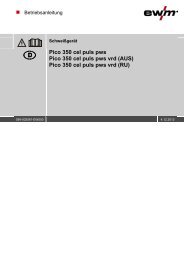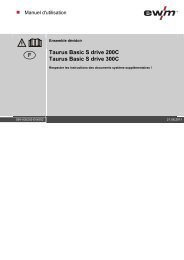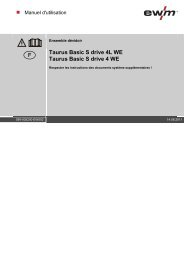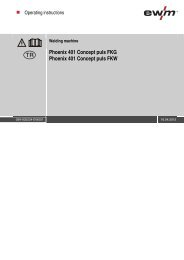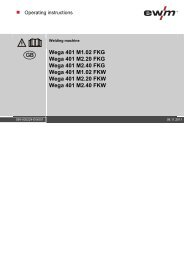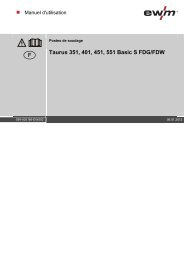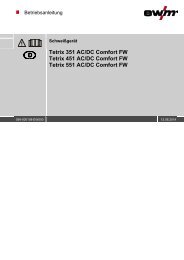Betriebsanleitung
Betriebsanleitung
Betriebsanleitung
- No tags were found...
Create successful ePaper yourself
Turn your PDF publications into a flip-book with our unique Google optimized e-Paper software.
GB<strong>Betriebsanleitung</strong> Fernsteller RTP 2, Seite 1-5Operating instructions Remote control RTP 2, page 6-10GB4 InbetriebnahmeDieser Fernsteller darf nur an die Fernstelleranschlußbuchse angeschlossen werden, dieals solche in der <strong>Betriebsanleitung</strong> des Schweißgerätes ausgewiesene ist!Der Anschluß darf niemals an einem Drahtvorschubgerät erfolgen!Fernstelleranschlußstecker nur bei ausgeschaltetem Schweißgerät in die Fernstellerbuchseeinstecken und verriegeln.• Fernsteller am Schweißgerät anschließen (Standardbetriebsanleitung des Schweißgerätesbeachten).• Schweißverfahren WIG oder E-Hand mit Umschalter D1 einstellen.• Pulsen , Punkten oder Standard-Betrieb mit Umschalter H1 einstellen.• Maximalen Schweißtstrom am Schweißgerät vorwählen (Drehknopf „AMP“).Der Drehknopf „AMP %“ am Schweißgerät ist ohne Funktion.4.1 Betriebsart Pulsen• Pulsstrom (B1) und Pausenstrom (F1) am Fernsteller einstellenBsp. mit folgenden Einstellungen:maximaler Schweißstrom am Schweißgerät: 120APulsstrom am Fernsteller: 50%Pausenstrom am Fernsteller: 25%Ergebnis:Pulsstrom = 60A (120A x 50%)Pausenstrom = 15A (120A x 50% x 25%)• Pulsfrequenz (C1) einstellen, siehe Kap. 4.4).Der Frequenzbereich ist abhängig von der Einstellung des Drehschalters (H1).• Balance (G1) einstellen, siehe Kap. 4.4).4.2 Betriebsart Punkten• Punktstrom (B1) am Fernsteller einstellen.• Punktzeit (C1) in Abhängigkeit von Umschalter (H1) einstellen(Der Drehknopf ist mit einer Doppelfunktion belegt)Bsp. mit folgenden Einstellungen:Drehschalter (H1) auf Stellung 0,25 bis 2,5secDrehknopf (C1) auf Stellung 15Ergebnis:15sec. / 0,1 = Punktzeit 1,5sec.4.3 Standard-Betrieb• Schweißstrom (B1) einstellen(0-100% von Drehknopf „AMP“ am Schweißgerät)• Verminderten Schweißstrom (F1) einstellen (0-100% von Drehknopf (B1),abrufbar mit dem 2. Brennertaster .Art. Nr.: 099-008084-EWM20 3 / 10 16.04.02
GB<strong>Betriebsanleitung</strong> Fernsteller RTP 2, Seite 1-5Operating instructions Remote control RTP 2, page 6-10GB5 SchaltplanArt. Nr.: 099-008084-EWM20 5 / 10 16.04.02
GB<strong>Betriebsanleitung</strong> Fernsteller RTP 2, Seite 1-5Operating instructions Remote control RTP 2, page 6-10GBThe remote control should be operated only with machines of the TRITON series. Theseoperating instructions are valid only in combination with the operating instructions for therelevant machineObserve the safety precautions listed in the standard operating instructions!Index .................................................................................................................................................page1 Description................................................................................................................................... 61.1 The operating modes ..........................................................................................................62 Technical data.............................................................................................................................. 63 Operating elements ..................................................................................................................... 74 Commissioning............................................................................................................................ 84.1 Pulse mode operation .........................................................................................................84.2 Spot mode operation........................................................................................................... 84.3 Standard operation.............................................................................................................. 84.4 Calculation examples of the pulse and spot times.............................................................. 95 Circuit diagram .......................................................................................................................... 101 Descriptionused for either MMA or TIG welding processes.The remote control can be used for pulse or spotmode operation or for simple welding currentregulation in the standard operating mode.The percentage strength of the welding currentdepends on the setting of the "AMP" rotary dialon the welding machine.Pulse frequency, balance and spot time. Theremote control can be are adjustable.1.1 The operating modes• Pulse modeThe welding current is periodically switched to and fro between pulse current and break current.Pulse frequency and balance adjustment can be set separately with rotary dials• Spot modeThe power source is switched on for a defined, adjustable time setting.For this purpose, the rotary dial is assigned the dual functions “pulse frequency/spot time”.• Standard modeThe remote control is used solely to set the welding current at “I1 (%AMP)“ and “I2 (%I1)“.2 Technical dataRTP 2Connector CableDimensions (L x W x H)Weight5 m260 x 147 x 75 mm1.5 kgArt. Nr.: 099-008084-EWM20 6 / 10 16.04.02
GB<strong>Betriebsanleitung</strong> Fernsteller RTP 2, Seite 1-5Operating instructions Remote control RTP 2, page 6-10GB4 CommissioningThis remote control may only be connected to the remote control connection socketidentified as such in the welding machine operating instructions.It must never be connected to a wire feed unit.The welding machine must always be switched off before the remote control plug isplugged into the remote control socket and locked.• Connect the remote control to the welding machine (observe standard operating instructions forthe welding machine).• Set changeover switch (D1) to TIG or MMA welding process.• Set changeover switch (H1) to pulse, spot or standard operating mode.• Preselect maximum welding current on the “AMP“ rotary dial of the welding machine.In this operating mode, the "AMP %" rotary dial on the welding machine has no function.4.1 Pulse mode operation• Set pulse (B1) and break (F1) current on the remote control,as with e.g. following settings:Maximum welding current on welding machine: 120APulse current on remote control: 50%Break current on remote control: 25%Result:Pulse current = 60A (120A x 50%)Break current = 15A (120A x 50% x 25%)• Set pulse frequency (C1), see Sect. 4.4(frequency range depends on the rotary switch setting (H1)).• Set balance (G1), see Sect. 4.44.2 Spot mode operation• Set spot current (B1) on remote control.• Set spot time (C1), depending on changeover switch (H1)(the rotary dial has been assigned dual functions),as with e.g. following settings:Rotary switch (H1) on position 0.25 to 2.5 sec.Rotary dial (C1) on position 15Result:15 sec. x0,1 = spot time 1.5 sec.4.3 Standard operation• Set welding current (B1)(0-100% on “AMP“ rotary dial on welding machine)• Set reduced welding current (F1) (0-100% on rotary dial (B1)),ready to be called up by the 2 nd torch trigger:Art. Nr.: 099-008084-EWM20 8 / 10 16.04.02
GB<strong>Betriebsanleitung</strong> Fernsteller RTP 2, Seite 1-5Operating instructions Remote control RTP 2, page 6-10GB4.4 Calculation examples of the pulse and spot timesFormula for calculation:PulsetimeBreaktime[ sec][ sec][%]Balance=100% × Frequency100% − Balance[ %]=100% × Frequency Hz[ Hz][ ]Example with following settings:Rotary dial range frequency range (H1): 0,25-2,5HzRotary dial frequency (C1): 1Hz (10Hz x 0,1)Rotary dial balance (G1): 50%• Pulsetime t 1:50%0,5sec =100% × 1Hz• Breaktime t 2:100% − 50%0,5sec =100% × 1HzRotary dial balance (G1): 10%• Pulsetime t 1:10%0,1sec =100% × 1Hz• Breaktime t 2:100% −10%0,9sec =100% × 1HzRotary dial balance (G1): 90%• Pulsetime t 1:90%0,9sec =100% × 1Hz• Breaktime t 2:100% − 90%0,1sec =100% × 1HzArt. Nr.: 099-008084-EWM20 9 / 10 16.04.02
GB<strong>Betriebsanleitung</strong> Fernsteller RTP 2, Seite 1-5Operating instructions Remote control RTP 2, page 6-10GB5 Circuit DiagramArt. Nr.: 099-008084-EWM20 10 / 10 16.04.02



